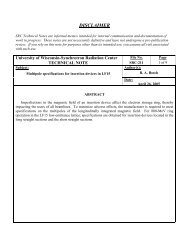SRC Users' Meeting - Synchrotron Radiation Center - University of ...
SRC Users' Meeting - Synchrotron Radiation Center - University of ...
SRC Users' Meeting - Synchrotron Radiation Center - University of ...
You also want an ePaper? Increase the reach of your titles
YUMPU automatically turns print PDFs into web optimized ePapers that Google loves.
IDENTIFICATION OF SUB-MICROMETER SILICATE INCLUSIONS IN<br />
ARCHEAN ZIRCONS WITH A X-RAY PHOTOELECTRON EMISSION<br />
SPECTROMICROSCOPY (X-PEEM)<br />
B. H. Frazer (1,2), G. De Stasio (1), B. Gilbert (3), A. Cavosie (4) and J. W. Valley (4)<br />
(1) <strong>University</strong> <strong>of</strong> Wisconsin-Madison, Dept. <strong>of</strong> Physics and <strong>Synchrotron</strong> <strong>Radiation</strong> <strong>Center</strong><br />
(2) Institute de Physique Appliquée, Ecole Polytechnique Fédérale de Lausanne<br />
(3) <strong>University</strong> <strong>of</strong> California-Berkeley, Earth and Planetary Science<br />
(4) <strong>University</strong> <strong>of</strong> Wisconsin, Department <strong>of</strong> Geology and Geophysics<br />
We recently optimized a new differential-thickness coating technique to analyze<br />
insulating samples with X-ray PhotoElectron Emission spectroMicroscopy (X-PEEM). X-PEEM<br />
is non-destructive, analyzes the chemical composition and crystal structure <strong>of</strong> minerals and can<br />
spatially resolve chemical species with a resolution presently reaching 35 nm. We tested the<br />
differential coating by analyzing a 4.4 billion-year-old zircon containing silicate inclusions. We<br />
observed quartz inclusions smaller than 1 µm in size, that could not be analyzed with any other<br />
non-destructive technique. We also present X-ray absorption near-edge structure (XANES)<br />
spectroscopy <strong>of</strong> 20 silicate, alumosilicate and aluminum oxide minerals and two glasses at the<br />
SiK and SiL 2,3 , and OK edges. The similar nearest-neighbor environments lead to similar spectral<br />
lineshapes at each edge, but the fine-structure differences allow individual and groups <strong>of</strong><br />
structurally similar minerals to be distinguished. By combining spectra and their first energy<br />
derivative from three absorption edges, we show that every mineral studied is distinguishable<br />
with XANES. These reference spectra, assist in the interpretation <strong>of</strong> sub-micrometer inclusions<br />
in archean zircons, studied with X-PEEM.
















